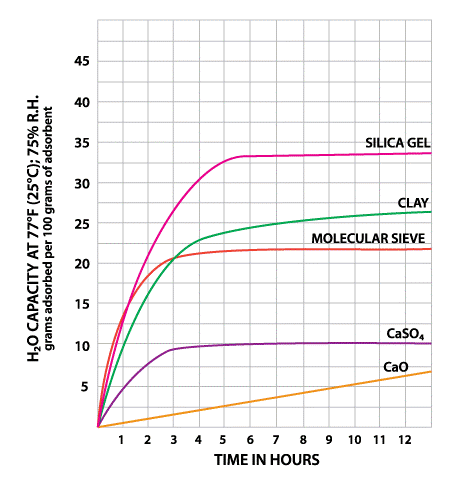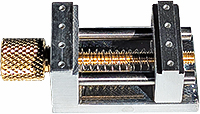
Technical Information Note
Indicating Silica Gel Desiccant
Introduction
Silica gel is one of most commonly used desiccant (sorbents) and consists of nano-porous Silicon Dioxide (SiO2). Silica gel comes in the form of glass beads with an average size of approximately 3mm (1/8”). In this state it is an indurated, non-toxic and non-flammable material. The open nano-porous structure with an average pore size of 2.4 – 2.5nm translates to a surface area of 800m2/g. Due to open nano-porous structure, it is able to adsorb and hold water molecules (moisture) up to a maximum of 40% of its own weight. The silica gel beads don't swell since the moisture is adsorbed at the surface.
As a result silica gel can reduce the relative humidity (RH) in a closed container to levels below 40% RH until the silica gel is saturated with water. Silica gel works in the temperature range from 0-100°C, but it performs best at room temperatures and medium to high humidity: 60-90% RH. Silica gel can be easily regenerated (dried) by heating.
Types of Silica Gel
Non-indicating silica gel beads have a glass like appearance and are clear to milky white; there is no indication as how much moisture has been adsorbed.
Indicating silica gel has been loaded with an colour changing indicator which shows when the silica gel becomes saturated. There are two types of indicating silica gel:
- Orange indicating silica gel contains methyl violet which shows an orange colour when dry and changes its colour to dark green when saturated. We offer the orange indicating silica gel since this is considered a non-toxic material.
- Blue indicating silica gel contains cobalt (II) chloride which shows dark blue when dry and pink when saturated. Blue indicating silica gel is considered to be toxic and carcinogenic in Europe and has to be treated as toxic material.
Indicating and non-indicating silica gel can be mixed to help determining when the silica becomes saturated. Silica gel displays its full colour change when it is saturated by holding 8-10% of its weight in moisture; at that point the silica gel should be changed or regenerated. However, the silica gel is still functional until it has adsorbed up to 40% of its weight in moisture. This means that there is large safety margin after the colour has changed.
Regeneration of indicating Silica Gel
Bulk silica gel can be easily regenerated (dried) by driving off the adsorbed water. This can be done in two ways:
- Heat the silica gel in an oven at 130-145°C for 2-3 hours
- Microwave at maximum 900 watt with intervals of three minutes until the colour indicates dry.
Spread the silica gel in a microwave safe and oven compatible shallow tray to speed up the drying process.
Caution: do not use temperatures above 150°C and do not use a microwave oven power over 900 watts.
If the Silica Gel is packed in containers, extra care is needed:
- when packed in boxes; remove from plastic box and regenerate
- when packed in Tyvek envelopes; maximum drying temperature is 120°C
- when packed in cans of capsules follow instructions from the manufacturer

Moisture adsorption capacities of different sorbent types showing the response and capacity.




